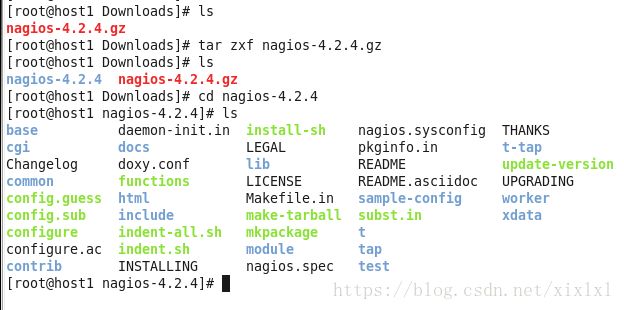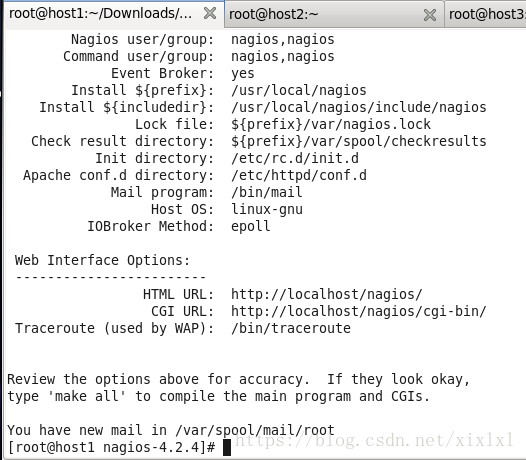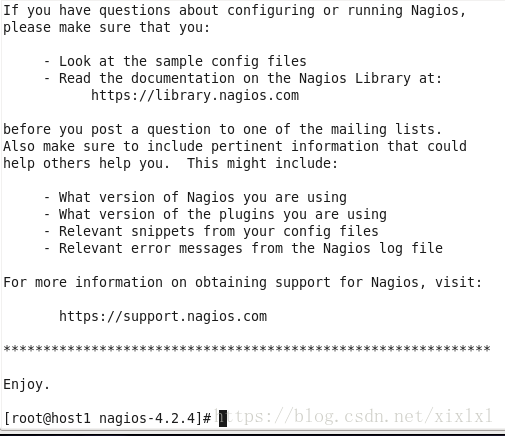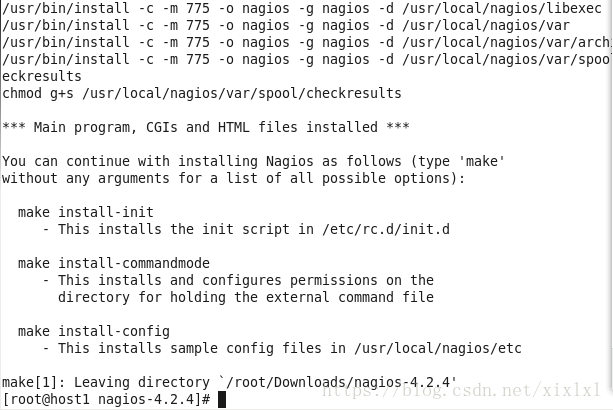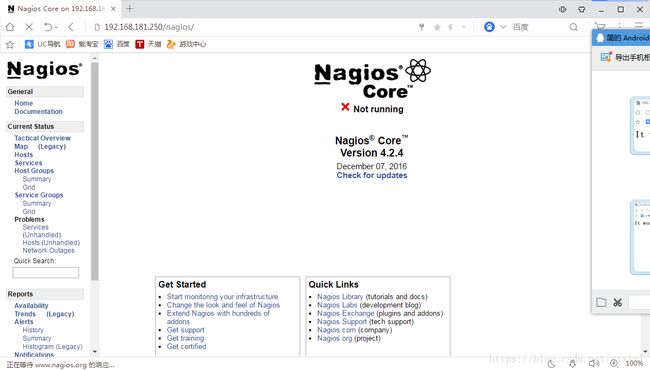nagios
Nagios是一款开源的电脑系统和网络监视工具,能有效监控Windows、Linux和Unix的主机状态,交换机路由器等网络设置,打印机等。在系统或服务状态异常时发出邮件或短信报警第一时间通知网站运维人员,在状态恢复后发出正常的邮件或短信通知。
官网:http://www.nagios.org/
主要功能
网络服务监控(SMTP、POP3、HTTP、NNTP、ICMP、SNMP、FTP、SSH)主机资源监控(CPU load、disk usage、system logs),也包括Windows主机(使用NSClient++ plugin)可以指定自己编写的Plugin通过网络收集数据来监控任何情况(温度、警告……)可以通过配置Nagios远程执行插件远程执行脚本远程监控支持SSH或SSL加通道方式进行监控简单的plugin设计允许用户很容易的开发自己需要的检查服务,支持很多开发语言(shell scripts、C++、Perl、ruby、Python、PHP、C#等)包含很多图形化数据Plugins(Nagiosgraph、Nagiosgrapher、PNP4Nagios等)可并行服务检查能够定义网络主机的层次,允许逐级检查,就是从父主机开始向下检查当服务或主机出现问题时发出通告,可通过email, pager, sms 或任意用户自定义的plugin进行通知能够自定义事件处理机制重新激活出问题的服务或主机自动日志循环支持冗余监控包括Web界面可以查看当前网络状态,通知,问题历史,日志文件等
Nagios工作原理
Nagios的功能是监控服务和主机,但是他自身并不包括这部分功能,所有的监控、检测功能都是通过各种插件来完成的。
启动Nagios后,它会周期性的自动调用插件去检测服务器状态,同时Nagios会维持一个队列,所有插件返回来的状态信息都进入队列,Nagios每次都从队首开始读取信息,并进行处理后,把状态结果通过web显示出来。
Nagios提供了许多插件,利用这些插件可以方便的监控很多服务状态。安装完成后,在nagios主目录下的/libexec里放有nagios自带的可以使用的所有插件,如,check_disk是检查磁盘空间的插件,check_load是检查CPU负载的,等等。每一个插件可以通过运行./check_xxx –h 来查看其使用方法和功能。
Nagios可以识别4种状态返回信息,即 0(OK)表示状态正常/绿色、1(WARNING)表示出现警告/黄色、2(CRITICAL)表示出现非常严重的错误/红色、3(UNKNOWN)表示未知错误/深黄色。Nagios根据插件返回来的值,来判断监控对象的状态,并通过web显示出来,以供管理员及时发现故障。
四种监控状态

Nagios 系统提供了一个插件NRPE。Nagios 通过周期性的运行它来获得远端服务器的各种状态信息。它们之间的关系如下图所示:

Nagios 通过NRPE 来远端管理服务
Nagios 执行安装在它里面的check_nrpe 插件,并告诉check_nrpe 去检测哪些服务。
通过SSL,check_nrpe 连接远端机子上的NRPE daemon
NRPE 运行本地的各种插件去检测本地的服务和状态(check_disk,..etc)
最后,NRPE 把检测的结果传给主机端的check_nrpe,check_nrpe 再把结果送到Nagios状态队列中。
Nagios 依次读取队列中的信息,再把结果显示出来。
这里在win7系统上使用vmware-redhat6.5三台主机
192.168.181.250 –host1 Apache、Php、Nagios、nagios-plugins
192.168.181.211 –host2 nagios-plugins、nrpe
192.168.181.212 –host3 NSClient++
火墙,selinux暂时关闭
Nagios服务端安装:
下载,解压nagios-4.2.4.tar.gz
[root@host1 Downloads]# ls
nagios-4.2.4.gz
[root@host1 Downloads]# tar zxf nagios-4.2.4.gz
rpm -q gcc glibc glibc-common gd gd-devel xinetd openssl-devel
yum install gcc glibc glibc-common gd gd-devel xinetd openssl-devel
[root@host1 nagios-4.2.4]# ./configure --prefix=/usr/local/nagios
[root@host1 nagios-4.2.4]# make all
创建nagios用户和用户组后安装
[root@host1 nagios-4.2.4]# useradd -s /sbin/nologin nagios
[root@host1 nagios-4.2.4]# chown -R nagios.nagios /usr/local/nagios
[root@host1 base]# cd /usr/local/nagios/
[root@host1 nagios]# ll -d ../nagios/
drwxr-xr-x. 3 nagios nagios 4096 May 31 11:40 ../nagios/
[root@host1 nagios-4.2.4]# make install ##安装完成根据提示,进行下边代码
[root@host1 nagios-4.2.4]# make install-init
[root@host1 nagios-4.2.4]# make install-commandmode
[root@host1 nagios-4.2.4]# make install-config[root@host1 nagios-4.2.4]# chkconfig --add nagios
[root@host1 nagios-4.2.4]# chkconfig --level 35 nagios on
[root@host1 nagios-4.2.4]# chkconfig --list nagios验证程序是否被正确安装
切换目录到安装路径(这里是/usr/local/nagios),看是否存在etc、bin、sbin、share、var 这五个目录,如果存在则可以表明程序被正确的安装到系统了。Nagios 各个目录用途说明如下:
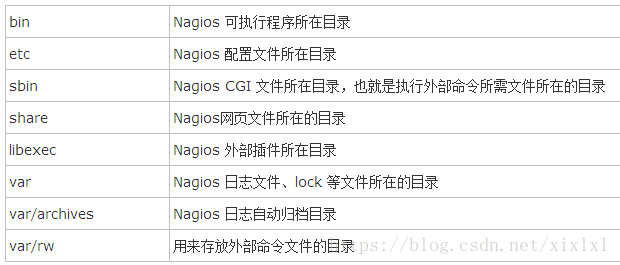
[root@host1 nagios-4.2.4]# cd /usr/local/nagios/
[root@host1 nagios]# ls
bin etc libexec sbin share var
安装Nagios 插件
官网下载:https://www.nagios.org/downloads/nagios-plugins/
[root@host1 Downloads]# tar zxf nagios-plugins-2.2.1.tar.gz
[root@host1 Downloads]# cd nagios-plugins-2.2.1
[root@host1 nagios-plugins-2.2.1]# ./configure --prefix=/usr/local/nagios
[root@host1 nagios-plugins-2.2.1]# make && make install安装与配置Apache和Php
Apache 和Php 不是安装nagios 所必须的,但是nagios提供了web监控界面,通过web监控界面可以清晰的看到被监控主机、资源的运行状态,因此,安装一个web服务是很必要的。 需要注意的是,nagios在nagios3.1.x版本以后,配置web监控界面时需要php的支持。
[root@host1 ~]# wget http://archive.apache.org/dist/httpd/httpd-2.2.23.tar.gz ##你得可以上网
@host1 ~]# tar zxf httpd-2.2.23.tar.gz
[root@host1 ~]# cd httpd-2.2.23
[root@host1 httpd-2.2.23]# ./configure --prefix=/usr/local/apache2 编译时入加 --with-included-apr 即可解决。
[root@host1 httpd-2.2.23]# make && make install
[root@host1 httpd-2.2.23]# vim /usr/local/apache2/conf/httpd.conf
找到:
User daemon
Group daemon 修改为
User nagios
Group nagios 然后找到
<IfModule dir_module>
DirectoryIndex index.html
IfModule> 修改为
<IfModule dir_module>
DirectoryIndex index.html index.php
IfModule> 接着增加如下内容:
AddType application/x-httpd-php .php 为了安全起见,一般情况下要让nagios 的web 监控页面必须经过授权才能访问,这需要增加验证配置,即在httpd.conf 文件最后添加如下信息:
#setting for nagios
ScriptAlias /nagios/cgi-bin "/usr/local/nagios/sbin"
<Directory "/usr/local/nagios/sbin">
AuthType Basic
Options ExecCGI
AllowOverride None
Order allow,deny
Allow from all
AuthName "Nagios Access"
AuthUserFile /usr/local/nagios/etc/htpasswd //用于此目录访问身份验证的文件
Require valid-user
</Directory>
Alias /nagios "/usr/local/nagios/share"
<Directory "/usr/local/nagios/share">
AuthType Basic
Options None
AllowOverride None
Order allow,deny
Allow from all
AuthName "nagios Access"
AuthUserFile /usr/local/nagios/etc/htpasswd
Require valid-user
</Directory> * 创建apache目录验证文件 *
在上面的配置中,指定了目录验证文件htpasswd,下面要创建这个文件:
[root@host1 ~]# /usr/local/apache2/bin/htpasswd -c /usr/local/apache2/conf/htpasswd lel
New password:
Re-type new password:
Adding password for user lel这样就在/usr/local/nagios/etc 目录下创建了一个htpasswd 验证文件,当通过http://192.168.181.250/nagios/ 访问时就需要输入用户名和密码了。
查看认证文件的内容
[root@host1 ~]# cat /usr/local/nagios/etc/htpasswd
lel:YTyEVub8mCR0o安装php
[root@host1 Downloads]# tar zxf php-5.6.36.tar.gz
[root@host1 Downloads]# cd php-5.6.36
[root@host1 php-5.6.36]# ./configure --prefix=/usr/local/php --with-apxs2=/usr/local/apache2/bin/apxs
[root@host1 php-5.6.36]# make && make install启动apache 服务
[root@host1 php-5.6.36]# /usr/local/apache2/bin/apachectl start
你也可以试试这个[root@host1 ~]# /usr/local/apache2/bin/httpd浏览器
http://192.168.181.250/
http://192.168.181.250/nagios二.配置Nagios
Nagios 主要用于监控一台或者多台本地主机及远程的各种信息,包括本机资源及对外的服务等。默认的Nagios 配置没有任何监控内容,仅是一些模板文件。若要让Nagios 提供服务,就必须修改配置文件,增加要监控的主机和服务,下面将详细介绍。
1 默认配置文件介绍
Nagios 安装完毕后,默认的配置文件在/usr/local/nagios/etc目录下。
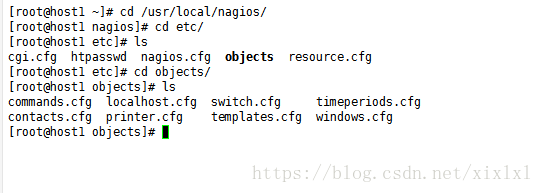

2配置文件之间的关系
在nagios的配置过程中涉及到的几个定义有:主机、主机组,服务、服务组,联系人、联系人组,监控时间,监控命令等,从这些定义可以看出,nagios各个配置文件之间是互为关联,彼此引用的。
成功配置出一台nagios监控系统,必须要弄清楚每个配置文件之间依赖与被依赖的关系,最重要的有四点:
第一:定义监控哪些主机、主机组、服务和服务组;
第二:定义这个监控要用什么命令实现;
第三:定义监控的时间段;
第四:定义主机或服务出现问题时要通知的联系人和联系人组。
3 配置Nagios
为了能更清楚的说明问题,同时也为了维护方便,建议将nagios各个定义对象创建独立的配置文件:
创建hosts.cfg文件来定义主机和主机组
创建services.cfg文件来定义服务
用默认的contacts.cfg文件来定义联系人和联系人组
用默认的commands.cfg文件来定义命令
用默认的timeperiods.cfg来定义监控时间段
用默认的templates.cfg文件作为资源引用文件
templates.cfg文件
nagios主要用于监控主机资源以及服务,在nagios配置中称为对象,为了不必重复定义一些监控对象,Nagios引入了一个模板配置文件,将一些共性的属性定义成模板,以便于多次引用。这就是templates.cfg的作用。
define contact{
name generic-contact ; ##联系人名称
service_notification_period 24x7 ; ##当服务出现异常时,发送通知的时间段,这个时间段"24x7"在timeperiods.cfg文件中定义
host_notification_period 24x7 ; ##当主机出现异常时,发送通知的时间段,这个时间段"24x7"在timeperiods.cfg文件中定义
service_notification_options w,u,c,r ; 这个定义的是“通知可以被发出的情况”。w即warn,表示警告状态,u即unknown,表示不明状态;c即criticle,表示紧急状态,r即recover,表示恢复状态;
也就是在服务出现警告状态、未知状态、紧急状态和重新恢复状态时都发送通知给使用者。
host_notification_options d,u,r ; 定义主机在什么状态下需要发送通知给使用者,d即down,表示宕机状态;u即unreachable,表示不可到达状态,r即recovery,表示重新恢复状态。
service_notification_commands notify-service-by-email ; 服务故障时,发送通知的方式,可以是邮件和短信,这里发送的方式是邮件;其中“notify-service-by-email”在commands.cfg文件中定义。
host_notification_commands notify-host-by-email ; 主机故障时,发送通知的方式,可以是邮件和短信,这里发送的方式是邮件;其中“notify-host-by-email”在commands.cfg文件中定义。
register 0 ; DONT REGISTER THIS DEFINITION - ITS NOT A REAL CONTACT, JUST A TEMPLATE!
}
define host{
name generic-host ; 主机名称,这里的主机名,并不是直接对应到真正机器的主机名;
; 乃是对应到在主机配置文件里所设定的主机名。
notifications_enabled 1 ; Host notifications are enabled
event_handler_enabled 1 ; Host event handler is enabled
flap_detection_enabled 1 ; Flap detection is enabled
failure_prediction_enabled 1 ; Failure prediction is enabled
process_perf_data 1 ; 其值可以为0或1,其作用为是否启用Nagios的数据输出功能;
; 如果将此项赋值为1,那么Nagios就会将收集的数据写入某个文件中,以备提取。
retain_status_information 1 ; Retain status information across program restarts
retain_nonstatus_information 1 ; Retain non-status information across program restarts
notification_period 24x7 ; 指定“发送通知”的时间段,也就是可以在什么时候发送通知给使用者。
register 0 ; DONT REGISTER THIS DEFINITION - ITS NOT A REAL HOST, JUST A TEMPLATE!
}
define host{
name linux-server ; 主机名称
use generic-host ; use表示引用,也就是将主机generic-host的所有属性引用到linux-server中来;
; 在nagios配置中,很多情况下会用到引用。
check_period 24x7 ; 这里的check_period告诉nagios检查主机的时间段
check_interval 5 ; nagios对主机的检查时间间隔,这里是5分钟。
retry_interval 1 ; 重试检查时间间隔,单位是分钟。
max_check_attempts 10 ; nagios对主机的最大检查次数,也就是nagios在检查发现某主机异常时,并不马上判断为异常状况;
; 而是多试几次,因为有可能只是一时网络太拥挤,或是一些其他原因,让主机受到了一点影响;
; 这里的10就是最多试10次的意思。
check_command check-host-alive ; 指定检查主机状态的命令,其中“check-host-alive”在commands.cfg文件中定义。
notification_period 24x7 ; 主机故障时,发送通知的时间范围,其中“workhours”在timeperiods.cfg中进行了定义;
; 下面会陆续讲到。
notification_interval 10 ; 在主机出现异常后,故障一直没有解决,nagios再次对使用者发出通知的时间。单位是分钟;
; 如果你觉得,所有的事件只需要一次通知就够了,可以把这里的选项设为0
notification_options d,u,r ; 定义主机在什么状态下可以发送通知给使用者,d即down,表示宕机状态;
; u即unreachable,表示不可到达状态;
; r即recovery,表示重新恢复状态。
contact_groups ts ; 指定联系人组,这个“admins”在contacts.cfg文件中定义。
register 0 ; DONT REGISTER THIS DEFINITION - ITS NOT A REAL HOST, JUST A TEMPLATE!
}
define host{
name windows-server ; The name of this host template
use generic-host ; Inherit default values from the generic-host template
check_period 24x7 ; By default, Windows servers are monitored round the clock
check_interval 5 ; Actively check the server every 5 minutes
retry_interval 1 ; Schedule host check retries at 1 minute intervals
max_check_attempts 10 ; Check each server 10 times (max)
check_command check-host-alive ; Default command to check if servers are "alive"
notification_period 24x7 ; Send notification out at any time - day or night
notification_interval 10 ; Resend notifications every 30 minutes
notification_options d,r ; Only send notifications for specific host states
contact_groups ts ; Notifications get sent to the admins by default
hostgroups windows-servers ; Host groups that Windows servers should be a member of
register 0 ; DONT REGISTER THIS - ITS JUST A TEMPLATE
}
define service{
name generic-service ; 定义一个服务名称
active_checks_enabled 1 ; Active service checks are enabled
passive_checks_enabled 1 ; Passive service checks are enabled/accepted
parallelize_check 1 ; Active service checks should be parallelized;
; (disabling this can lead to major performance problems)
obsess_over_service 1 ; We should obsess over this service (if necessary)
check_freshness 0 ; Default is to NOT check service 'freshness'
notifications_enabled 1 ; Service notifications are enabled
event_handler_enabled 1 ; Service event handler is enabled
flap_detection_enabled 1 ; Flap detection is enabled
failure_prediction_enabled 1 ; Failure prediction is enabled
process_perf_data 1 ; Process performance data
retain_status_information 1 ; Retain status information across program restarts
retain_nonstatus_information 1 ; Retain non-status information across program restarts
is_volatile 0 ; The service is not volatile
check_period 24x7 ; 这里的check_period告诉nagios检查服务的时间段。
max_check_attempts 3 ; nagios对服务的最大检查次数。
normal_check_interval 5 ; 此选项是用来设置服务检查时间间隔,也就是说,nagios这一次检查和下一次检查之间所隔的时间;
; 这里是5分钟。
retry_check_interval 2 ; 重试检查时间间隔,单位是分钟。
contact_groups ts ; 指定联系人组
notification_options w,u,c,r ; 这个定义的是“通知可以被发出的情况”。w即warn,表示警告状态;
; u即unknown,表示不明状态;
; c即criticle,表示紧急状态,r即recover,表示恢复状态;
; 也就是在服务出现警告状态、未知状态、紧急状态和重新恢复后都发送通知给使用者。
notification_interval 10 ; Re-notify about service problems every hour
notification_period 24x7 ; 指定“发送通知”的时间段,也就是可以在什么时候发送通知给使用者。
register 0 ; DONT REGISTER THIS DEFINITION - ITS NOT A REAL SERVICE, JUST A TEMPLATE!
}
define service{
name local-service ; The name of this service template
use generic-service ; Inherit default values from the generic-service definition
max_check_attempts 4 ; Re-check the service up to 4 times in order to determine its final (hard) state
normal_check_interval 5 ; Check the service every 5 minutes under normal conditions
retry_check_interval 1 ; Re-check the service every minute until a hard state can be determined
register 0 ; DONT REGISTER THIS DEFINITION - ITS NOT A REAL SERVICE, JUST A TEMPLATE!
}b. resource.cfg文件
resource.cfg是nagios的变量定义文件,文件内容只有一行:
$USER1$=/usr/local/nagios/libexec其中,变量 USER1 U S E R 1 指定了安装nagios插件的路径,如果把插件安装在了其它路径,只需在这里进行修改即可。需要注意的是,变量必须先定义,然后才能在其它配置文件中进行引用。
c. commands.cfg文件
此文件默认是存在的,无需修改即可使用,当然如果有新的命令需要加入时,在此文件进行添加即可。
#notify-host-by-email命令的定义
define command{
command_name notify-host-by-email #命令名称,即定义了一个主机异常时发送邮件的命令。
command_line /usr/bin/printf "%b" "***** Nagios *****\n\nNotification Type: $NOTIFICATIONTYPE$\nHost: $HOSTNAME$\nState: $HOSTSTATE$\nAddress: $HOSTADDRESS$\nInfo: $HOSTOUTPUT$\n\nDate/Time: $LONGDATETIME$\n" | /bin/mail -s "** $NOTIFICATIONTYPE$ Host Alert: $HOSTNAME$ is $HOSTSTATE$ **" $CONTACTEMAIL$ #命令具体的执行方式。
}
#notify-service-by-email命令的定义
define command{
command_name notify-service-by-email #命令名称,即定义了一个服务异常时发送邮件的命令
command_line /usr/bin/printf "%b" "***** Nagios *****\n\nNotification Type: $NOTIFICATIONTYPE$\n\nService: $SERVICEDESC$\nHost: $HOSTALIAS$\nAddress: $HOSTADDRESS$\nState: $SERVICESTATE$\n\nDate/Time: $LONGDATETIME$\n\nAdditional Info:\n\n$SERVICEOUTPUT$\n" | /bin/mail -s "** $NOTIFICATIONTYPE$ Service Alert: $HOSTALIAS$/$SERVICEDESC$ is $SERVICESTATE$ **" $CONTACTEMAIL$
}
#check-host-alive命令的定义
define command{
command_name check-host-alive #命令名称,用来检测主机状态。
command_line $USER1$/check_ping -H $HOSTADDRESS$ -w 3000.0,80% -c 5000.0,100% -p 5
# 这里的变量$USER1$在resource.cfg文件中进行定义,即$USER1$=/usr/local/nagios/libexec;
# 那么check_ping的完整路径为/usr/local/nagios/libexec/check_ping;
# “-w 3000.0,80%”中“-w”说明后面的一对值对应的是“WARNING”状态,“80%”是其临界值。
# “-c 5000.0,100%”中“-c”说明后面的一对值对应的是“CRITICAL”,“100%”是其临界值。
# “-p 1”说明每次探测发送一个包。
}
define command{
command_name check_local_disk
command_line $USER1$/check_disk -w $ARG1$ -c $ARG2$ -p $ARG3$ #$ARG1$是指在调用这个命令的时候,命令后面的第一个参数。
}
define command{
command_name check_local_load
command_line $USER1$/check_load -w $ARG1$ -c $ARG2$
}
define command{
command_name check_local_procs
command_line $USER1$/check_procs -w $ARG1$ -c $ARG2$ -s $ARG3$
}
define command{
command_name check_local_users
command_line $USER1$/check_users -w $ARG1$ -c $ARG2$
}
define command{
command_name check_local_swap
command_line $USER1$/check_swap -w $ARG1$ -c $ARG2$
}
define command{
command_name check_ftp
command_line $USER1$/check_ftp -H $HOSTADDRESS$ $ARG1$
}
define command{
command_name check_http
command_line $USER1$/check_http -I $HOSTADDRESS$ $ARG1$
}
define command{
command_name check_ssh
command_line $USER1$/check_ssh $ARG1$ $HOSTADDRESS$
}
define command{
command_name check_ping
command_line $USER1$/check_ping -H $HOSTADDRESS$ -w $ARG1$ -c $ARG2$ -p 5
}
define command{
command_name check_nt
command_line $USER1$/check_nt -H $HOSTADDRESS$ -p 12489 -v $ARG1$ $ARG2$
}d. hosts.cfg文件
此文件默认不存在,需要手动创建,hosts.cfg主要用来指定被监控的主机地址以及相关属性信息,根据实验目标配置如下:
define host{
use linux-server #引用主机linux-server的属性信息,linux-server主机在templates.cfg文件中进行了定义。
host_name Nagios-Linux #主机名
alias Nagios-Linux #主机别名
address 192.168.1.111 #被监控的主机地址,这个地址可以是ip,也可以是域名。
}
#定义一个主机组
define hostgroup{
hostgroup_name bsmart-servers #主机组名称,可以随意指定。
alias bsmart servers #主机组别名
members Nagios-Linux #主机组成员,其中“Nagios-Linux”就是上面定义的主机。
}注意:在/usr/local/nagios/etc/objects 下默认有localhost.cfg 和windows.cfg 这两个配置文件,localhost.cfg 文件是定义监控主机本身的,windows.cfg 文件是定义windows 主机的,其中包括了对host 和相关services 的定义。所以在本次实验中,将直接在localhost.cfg 中定义监控主机(Nagios-Server),在windows.cfg中定义windows 主机(Nagios-Windows)。根据自己的需要修改其中的相关配置,详细如下:
localhost.cfg
define host{
use linux-server ; Name of host template to use
; This host definition will inherit all variables that are defined
; in (or inherited by) the linux-server host template definition.
host_name Nagios-Server
alias Nagios-Server
address 127.0.0.1
}
define hostgroup{
hostgroup_name linux-servers ; The name of the hostgroup
alias Linux Servers ; Long name of the group
members Nagios-Server ; Comma separated list of hosts that belong to this group
}
define service{
use local-service ; Name of service template to use
host_name Nagios-Server
service_description PING
check_command check_ping!100.0,20%!500.0,60%
}
define service{
use local-service ; Name of service template to use
host_name Nagios-Server
service_description Root Partition
check_command check_local_disk!20%!10%!/
}
define service{
use local-service ; Name of service template to use
host_name Nagios-Server
service_description Current Users
check_command check_local_users!20!50
}
define service{
use local-service ; Name of service template to use
host_name Nagios-Server
service_description Total Processes
check_command check_local_procs!250!400!RSZDT
}
define service{
use local-service ; Name of service template to use
host_name Nagios-Server
service_description Current Load
check_command check_local_load!5.0,4.0,3.0!10.0,6.0,4.0
}
define service{
use local-service ; Name of service template to use
host_name Nagios-Server
service_description Swap Usage
check_command check_local_swap!20!10
}
define service{
use local-service ; Name of service template to use
host_name Nagios-Server
service_description SSH
check_command check_ssh
notifications_enabled 0
}
define service{
use local-service ; Name of service template to use
host_name Nagios-Server
service_description HTTP
check_command check_http
notifications_enabled 0
}windows.cfg
define host{
use windows-server ; Inherit default values from a template
host_name Nagios-Windows ; The name we're giving to this host
alias My Windows Server ; A longer name associated with the host
address 192.168.1.113 ; IP address of the host
}
define hostgroup{
hostgroup_name windows-servers ; The name of the hostgroup
alias Windows Servers ; Long name of the group
}
define service{
use generic-service
host_name Nagios-Windows
service_description NSClient++ Version
check_command check_nt!CLIENTVERSION
}
define service{
use generic-service
host_name Nagios-Windows
service_description Uptime
check_command check_nt!UPTIME
}
define service{
use generic-service
host_name Nagios-Windows
service_description CPU Load
check_command check_nt!CPULOAD!-l 5,80,90
}
define service{
use generic-service
host_name Nagios-Windows
service_description Memory Usage
check_command check_nt!MEMUSE!-w 80 -c 90
}
define service{
use generic-service
host_name Nagios-Windows
service_description C:\ Drive Space
check_command check_nt!USEDDISKSPACE!-l c -w 80 -c 90
}
define service{
use generic-service
host_name Nagios-Windows
service_description W3SVC
check_command check_nt!SERVICESTATE!-d SHOWALL -l W3SVC
}
define service{
use generic-service
host_name Nagios-Windows
service_description Explorer
check_command check_nt!PROCSTATE!-d SHOWALL -l Explorer.exe
}e. services.cfg文件
此文件默认也不存在,需要手动创建,services.cfg文件主要用于定义监控的服务和主机资源,例如监控http服务、ftp服务、主机磁盘空间、主机系统负载等等。Nagios-Server 和Nagios-Windows 相关服务已在相应的配置文件中定义,所以这里只需要定义Nagios-Linux 相关服务即可,这里只定义一个检测是否存活的服务来验证配置文件的正确性,其他服务的定义将在后面讲到。
define service{
use local-service #引用local-service服务的属性值,local-service在templates.cfg文件中进行了定义。
host_name Nagios-Linux #指定要监控哪个主机上的服务,“Nagios-Server”在hosts.cfg文件中进行了定义。
service_description check-host-alive #对监控服务内容的描述,以供维护人员参考。
check_command check-host-alive #指定检查的命令。
} 